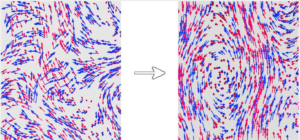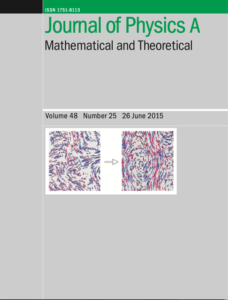Peer Review: Through the Looking Glass
Five years ago, when carrying out direct numerical simulations (DNS) of isotropic turbulence at Edinburgh, we made a surprising discovery. We found that turbulence states died away at very low values of the Reynolds number and the flow became self-organised, taking the form of a Beltrami flow, which has velocity and vorticity vectors aligned. This work is reported in [1] below, and illustrated by the following figure.

A video of the simulation, showing the symmetry-breaking transition, complete with characteristic ‘critical slowing down’, can be found at the online article [1]: https://doi.org/10.1088/1751-8113/48/25/25FT01
The link to the video can be found under the heading Supplementary Data. Downloading this should be straightforward using Windows, but if using a Mac you may have to have an app such as VLC installed.
The article [1] was featured on the front cover of the journal, thus:

It was downloaded hundreds of times within a few days of publication and the total number of downloads now stands at 2708.
That sounds like a success story and you may well wonder why I want to feature this as yet another problem with peer review. The answer to that lies in the fact that we first submitted it to Physical Review Letters and that was such an bizarre experience that it deserves to be told!
Normally I would refer to the two referees as Referee A and Referee B, but as their behaviour seemed to belong to the Looking Glass world (that turbulence assessment so often is) I have decided to call them Tweedledum and Tweedledee.
First, Tweedledum said that he didn’t understand how we were forcing the turbulence. He had never seen anything like that before. Perhaps the strange behaviour was due to our strange forcing. He didn’t think that our Letter should be published.
Then, Tweedledee said that he didn’t understand how we were forcing the turbulence. He also had never seen anything like that before. Perhaps the strange behaviour was due to our strange forcing. He also didn’t think that our Letter should be published.
In Alice Through the Looking Glass, the twins had a famous battle. That did not happen in the present case where they were in perfect agreement; although Tweedledum (or was it Tweedledee?) suggested that perhaps if we did a lot more work and wrote it up as a much longer article, then it might be suitable for publication. This rather misses the point of having a journal like PRL!
When we submitted our paper to J. Phys. A, we pointed out the following: our method of forcing is known as negative damping; it was introduced to turbulence theory in 1965 by Jack Herring; it was first used in DNS in 1997 by Luc Machiels; has subsequently been used in numerous investigations; and in 2005 was studied theoretically by Doering and Petrov [2]. Not precisely an obscure technique then. But what an intellectually feeble performance from Tweedledum and Tweedledee. No wonder problems in turbulence remain unresolved for generations.
One might end up by wondering what if any harm had been done by the lack of scholarly behaviour on the part of these referees who were presumably chosen to be representative of the turbulence community. After all, the paper has been published and has clearly aroused quite a lot of interest. The trouble is, I suspect that J. Phys. A does not have the same visibility among turbulence researchers as PRL. In that case the numerous downloads may reflect the fact that many physicists are interested in an example of a nonlinear phase transition without necessarily having any interest in turbulence. More generally, over the years it seems to me that turbulence referees tend to exert a frictional drag on the process of publishing papers. Many of them give the impression of not wanting the pure pool of ignorance to be spoiled by any new understanding or knowledge.
[1] W. D. McComb, M. F. Linkmann, A. Berera, S. R. Yoffe, and B. Jankauskas. Self-organization and transition to turbulence in isotropic fluid motion driven by negative damping at low wavenumbers. J. Phys. A Math.Theor., 48:25FT01, 2015.
[2] Charles R. Doering and Nikola P. Petrov. Low-wavenumber forcing and turbulent energy dissipation. Progress in Turbulence, 101(1):11-18, 2005.



